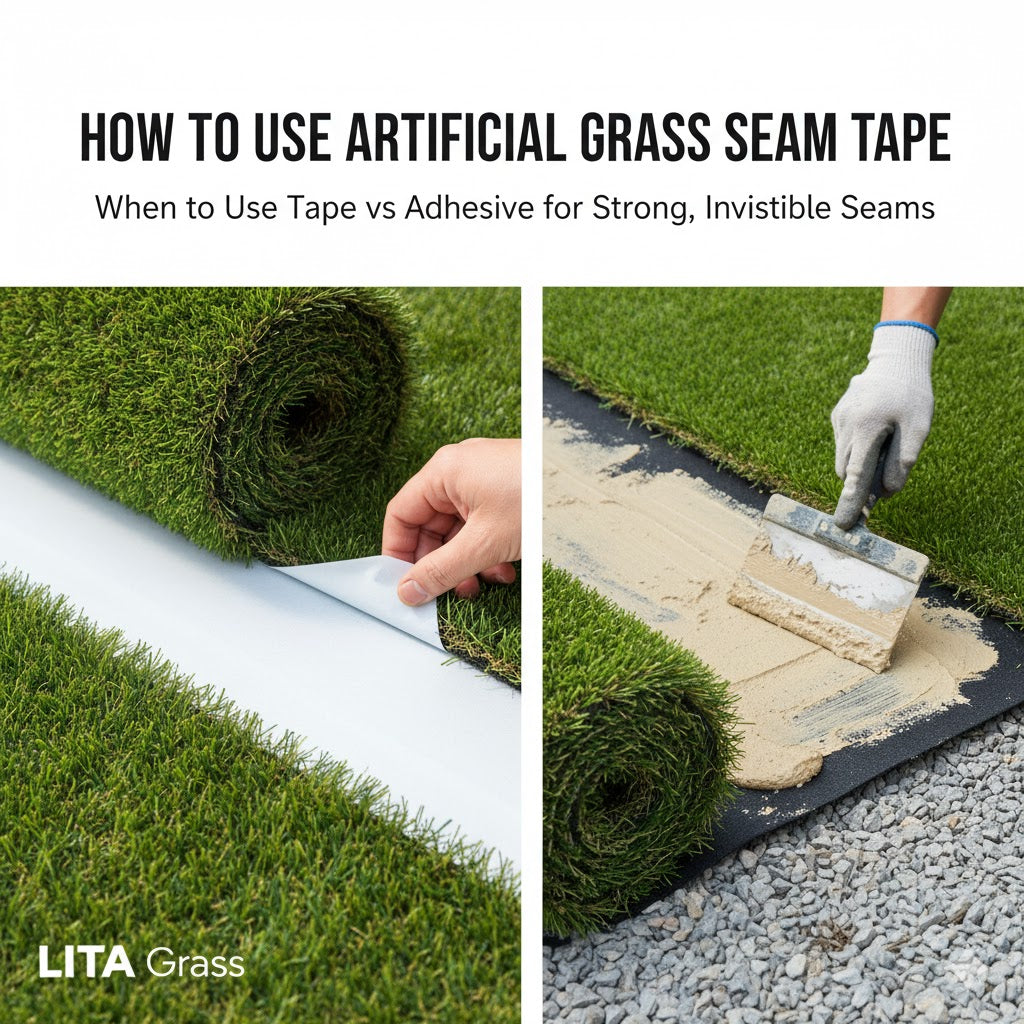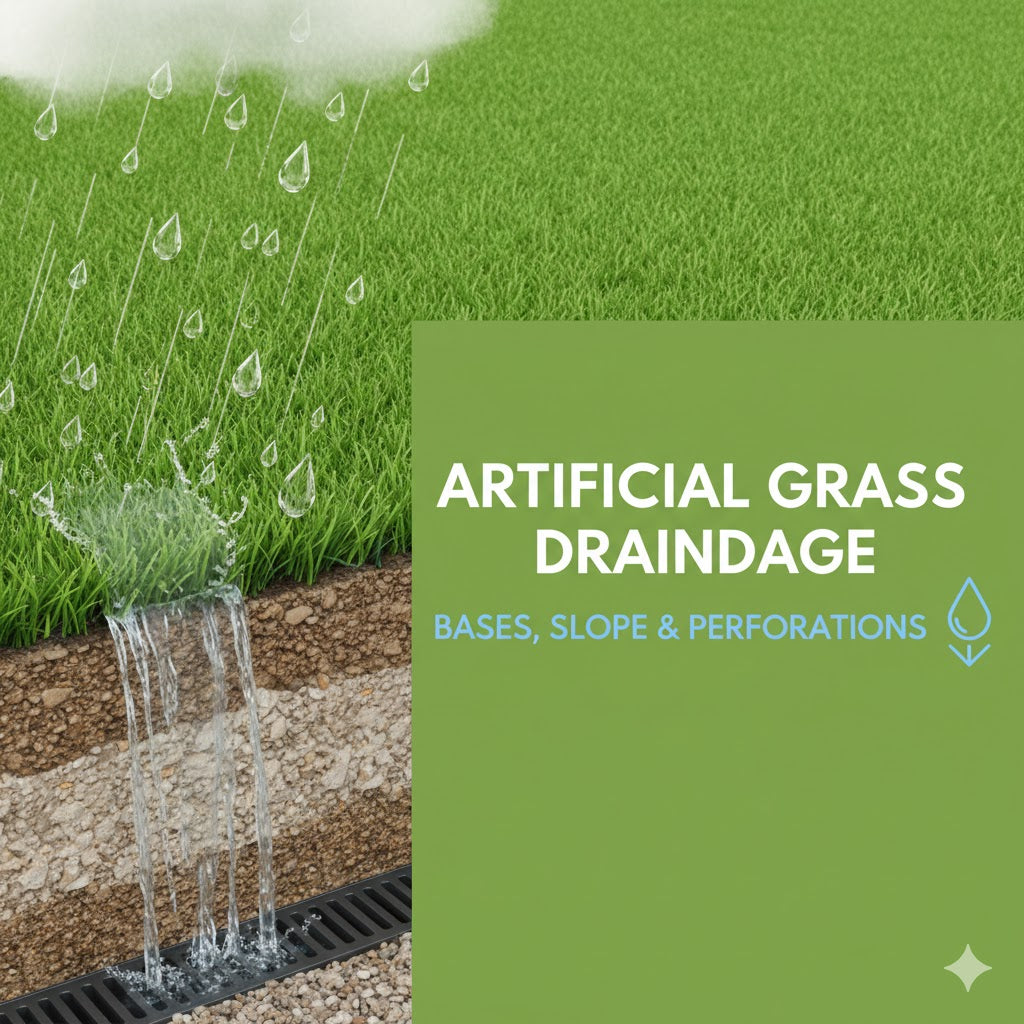Joining two pieces of turf is not hard once you know the right method. The challenge is choosing whether to rely on artificial grass seam tape or use glue with tape. Both options work, but each has its place.
Artificial grass seam tape is quick and clean. It works well for small lawns, patios, or light-use areas. On the other hand, tape with turf adhesive takes more time, but it creates stronger seams that last under heavy use.
The goal is simple: you want a seam that disappears into the grass and holds firm for years. In this guide, we’ll look at what seam tape is, how to use it, and when glue is the better choice.
What Is Artificial Grass Seam Tape?
Artificial grass seam tape is a strip that helps join two pieces of turf together. You place it under the edges of the grass and bond them over the tape. The result is a single surface that looks like one large roll of turf instead of two smaller ones. Suppliers such as LitaGrass carry different seam tapes for lawns, putting greens, and sports fields, making it easier to pick the right type.
Most seam tapes use a non-woven fabric base. This base is strong, waterproof, and built to handle outdoor elements like sun and rain. Some tapes come pre-coated with adhesive, usually a butyl or hot melt pressure-sensitive layer. Others are plain and need turf adhesive spread on top.
The tape keeps the grass edges from moving apart. It also helps hide the line where two rolls meet. With the right product and method, seams stay flat, secure, and nearly invisible.
How It Differs From Liquid Adhesive
Seam tape and liquid adhesive do the same job, but they work in different ways. Tape creates a ready base for the turf edges, while adhesive is spread or troweled onto that base to hold everything in place.
Self-adhesive seam tape is quick. You peel off the film and press the grass down. It saves time and avoids the mess of glue. This method is popular for small lawns, patios, and light-use areas.
Tape with turf adhesive takes longer. You roll out the tape, spread the glue, and then press the turf edges into it. The process is slower, but the joint is stronger. This option is best for sports fields, playgrounds, and busy spaces where seams face heavy use.

Tape vs Adhesive: The Quick Decision Guide
Choosing between artificial grass seam tape and turf adhesive can feel confusing. A simple rule can help. Use self-adhesive seam tape when speed matters and the area won’t face heavy wear. Use seam tape with glue when strength and durability matter most.
Think about traffic. A backyard lawn or balcony gets light use, so tape alone often works well. Sports fields, golf areas, or busy commercial spaces need seams that won’t shift, so adhesive is the safer choice.
Also consider time. Self-adhesive tape makes installation quick and clean. Glue takes more effort and a longer cure, but it produces a bond that lasts.
Finally, think about cost. Tape-only jobs reduce labor and cleanup. Adhesive requires more setup, but it may prevent repairs later. The right choice balances speed, strength, and budget for your project.
Tools & Materials Checklist
Before you start, gather the right tools. Having them ready makes the work smoother and faster.
- Utility knife – for trimming turf edges clean and straight.
- Straightedge or ruler – to guide your cuts.
- Carpet kicker – helps align the turf and close gaps.
- Temporary nails or pins – to hold grass in place while you work.
- Seam tape – either self-adhesive or plain tape for use with glue.
- Turf adhesive – only if you use non-adhesive seam tape.
- Roller or weights – for pressing seams down evenly.
- Brush or broom – to lift and blend the grass fibers after the seam is set.
Having these items on hand prevents delays and mistakes during installation.
Step-by-Step: Using Self-Adhesive Artificial Grass Seam Tape
Self-adhesive tape makes joining turf quick and clean. Follow these steps for a neat, strong seam.
1) Trim and Square the Edges
Cut along the back of each turf piece with a utility knife. Remove 3–4 gauge rows if needed. This gives you clean edges that fit well.
2) Align Pile and Set Seam Gap
Lay the two pieces side by side. Keep the fibers facing the same direction. Leave a small gap, about 2–3 mm, so the blades can blend without bunching.
3) Place the Seam Tape
Roll out the tape under the seam with the sticky side up. Center it so both turf edges land evenly. Peel back part of the film to start, but not all at once.
4) Set and Secure the Turf
Lower one side of the turf onto the tape. Press down firmly. Then peel the rest of the film and lower the other side. Work slowly to keep the seam straight.
Pro Tips
- Apply weight or step gently on the seam for better contact.
- Avoid letting fibers stick into the adhesive.
- Use nails or pins every few feet if the seam is long.

Step-by-Step: Non-Adhesive Seam Tape + Turf Adhesive (Pro Method)
When you need maximum strength, use seam tape with turf adhesive. This method takes more time, but the seam will last under heavy use.
1) Dry Fit and Trim the Edges
Lay out the turf pieces where they will go. Trim factory edges with a utility knife so both sides are straight. Make sure the grass fibers run in the same direction.
2) Lay the Seam Tape
Roll the non-adhesive tape under the joint. Keep the fabric side up and the waterproof layer down. Align it so the seam runs right down the middle.
3) Apply the Turf Adhesive
Spread glue evenly over the top of the tape using a notched trowel or spreader. Cover the width of the tape without letting glue squeeze out. Follow the adhesive’s open time carefully.
4) Close and Secure the Seam
Fold both turf edges down into the glue at the same time. Press firmly and brush fibers so they don’t get stuck. Place weights or roll over the seam to ensure even contact.
5) Let It Cure
Keep the seam dry and free from traffic until the adhesive sets. Full curing time depends on the product and weather.
Specs That Matter When Choosing Artificial Grass Seam Tape
Not all seam tapes are the same. A few key details make the difference between a weak joint and a long-lasting one.
- Width – Look for tape that is at least 6 inches wide. Wider tape, up to 12 inches, gives more bonding surface and stronger seams.
- Base material – Most quality tapes use a non-woven fabric base. This material is stable, waterproof, and resists tearing.
- Adhesive type – Self-adhesive tapes often use butyl or hot melt pressure-sensitive adhesive. These provide strong adhesion and hold up against outdoor elements.
- UV resistance – Good seam tape should resist sun damage. Without UV protection, adhesive layers can break down over time.
- Backing and liner – Some products include a moisture barrier film or reinforced backing. Split liners make it easier to peel and set one side at a time.
- Durability – Check the product for long-lasting performance claims. Many landscape tapes last six to eight years when used correctly.
Cost, Durability & Warranty Expectations
Artificial grass seam tape comes in rolls, and prices vary by width, length, and brand. Self-adhesive tape usually costs less overall because you don’t need extra glue or tools. Tape that requires turf adhesive can add to installation costs but delivers more strength.
Durability depends on the type you choose and where it’s installed. Self-adhesive tape can last 6–8 years in normal residential lawns. Seam tape with glue can last even longer, especially in sports fields or commercial spaces with heavy traffic.
Use Cases & Surfaces: Where Each Option Works Best
Artificial grass seam tape works in many places, but the best type depends on how the surface will be used.
For residential lawns, patios, balconies, or garden paths, self-adhesive tape is a good choice. It is quick to install, clean to use, and strong enough for light to medium foot traffic. It also works well over concrete surfaces and decks where glue can be messy.
For sports fields, golf courses, dog runs, or commercial spaces, seam tape with turf adhesive is better. These areas face heavy traffic, so stronger joints are needed. Glue with tape ensures seams stay flat and safe under constant use.
For temporary setups such as exhibitions, film sets, or office spaces, self-adhesive tape works best. It is easy to cut, simple to remove, and makes the process quick without extra glue.
Wholesale programs from suppliers such as LitaGrass also make it easier for contractors to buy rolls and seaming products in bulk for bigger jobs.

Troubleshooting Seams (and How to Hide Them)
Even with care, seams can sometimes show or fail. Knowing the common issues helps you fix them quickly.
Peaking or raised seams often happen when edges are not cut straight or the seam gap is too wide. Trim the edges again, reset the gap, and press the seam flat.
Weak bonds usually come from installing on cold or wet surfaces, or using expired tape or glue. Always check the weather and product dates before you start.
Visible lines appear when turf fibers are misaligned. Make sure the grass pile runs in the same direction on both pieces. Brushing fibers upward after joining also helps hide the seam.
Quick fixes: Add extra glue at the ends, place a few nails or pins along long seams, or reweight the area until the bond sets.
FAQs
How to join two pieces of artificial grass?
Cut straight edges, lay seam tape under the joint, and press both pieces into it. Use adhesive if the area needs extra strength.
How to hide seams in fake grass?
Match the pile direction, keep a small gap, and brush fibers to blend. Proper cutting and alignment are key.
How to seam tape artificial turf?
Place seam tape under the edges, peel or spread adhesive, and press the turf down evenly. Add weight to secure the bond.
Why are people getting rid of artificial grass?
Some worry about heat, drainage, or disposal at end of life. Still, many people use it because it saves water, lowers upkeep, and creates clean green space.
Summary: When to Reach for Artificial Grass Seam Tape vs Adhesive
Both methods work, but the right choice depends on your project. Use self-adhesive artificial grass seam tape when you need a fast, clean, and simple join. It’s best for residential lawns, patios, balconies, and other light-use areas.
Use seam tape with turf adhesive when strength and durability matter most. This method takes longer but creates seams that can handle heavy traffic in sports fields, golf courses, or busy commercial spaces.
Need the right tape for your project? LitaGrass carries self-adhesive seam tape for simple installs and pro seam tape with glue for heavy-use areas.



Leave a comment
This site is protected by hCaptcha and the hCaptcha Privacy Policy and Terms of Service apply.